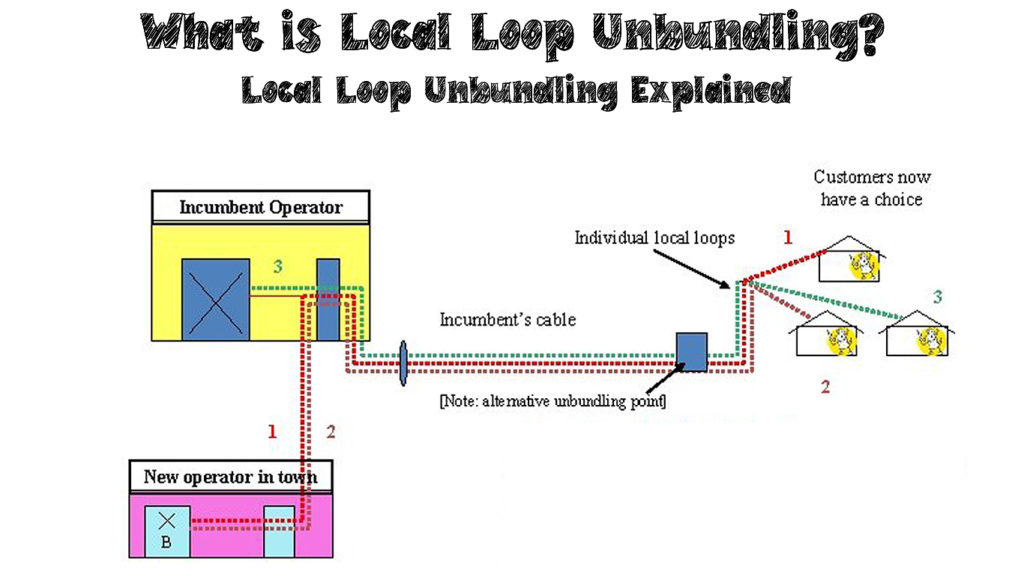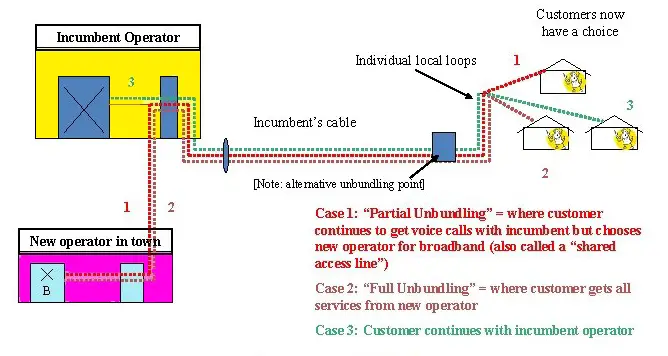Telecommunication companies constantly compete to offer their customers the best services. However, the competition was minimal in the past since there were only a few telecommunication companies.
The few telecommunications companies present would control all connections to the customer’s premise, including the local loop. Thus, they would be the sole providers of services such as telephone services to the users within the area.
However, governments in many countries introduced new laws to allow new telecommunication companies to use the available local loops. Thus, local loop unbundling allows different telecommunication companies to share the local loops.

CONTENTS
What is a Local Loop?
In telecommunication systems, a local loop is a physical connection consisting of wires between a consumer and the network carrier. Therefore, the wires run from the demarcation point in the user’s premises to the telephone switch of the network provider.
The wires, also known as last-mile connections, are responsible for transmitting analog and digital signals. The incumbent local exchange carrier will offer services such as data and voice communications to the customer through the wires.
Telephone modems would convert digital data from the computer and transmit them as analog signals using telephone lines. However, the Digital Subscriber Lines (DSL) would later replace analog transmission methods and create digital local loops.
The network carrier uses cables, usually made from copper, fiber, or coaxial cables. Copper wires are generally in twisted pairs but offer slower signal transmission than coaxial cables, which have higher bandwidth.
However, newer fiber cables use fiber optics technology which offers faster data transmission than copper and coaxial cables. Fiber wires are the most expensive due to the high cost of the cables and installation fees.
Some of the cable connections used by the network carriers include:
- Telephone or internet cables
- Power lines
- Fiber optic wires
- Wireless local loops
- Satellite cable connections
Wireless local loops (WLL) are more prevalent in use than traditional local loops since they use wireless links instead. The wireless link will connect the network carriers to the customer and transmit analog and digital signals.
Even as WLL systems grow, the network carriers can still connect to their customers using a radio unit. The PSTN allows operators to use the available infrastructure to transmit their services through the radio units.
From the customer’s side, the radio unit will connect to their cables inside or outside their buildings. Additionally, the unit has a battery backup, ensuring that customers keep receiving telephone services when the power is out.
Some of the benefits of using WLL technology include:
- It is cost-effective since it does not require the use of more copper wires to expand its system
- It is a more secure form of data transmission due to the use of data encryption features
- Areas that may lack cable infrastructure can still access essential telephone services
- It offers faster speeds in the transmission of data with better quality than previous analog systems
- It easily integrates with available infrastructure from the PSTN
Therefore, local loops are essential in the analog and digital data transmission from network carriers to the customers. With WLL technology, customers can equally access phone services even in dominantly rural areas without requiring traditional wiring.
Local Loop Explained
What is Local Loop Unbundling?
Newer telecommunication companies wanted to offer better telephony and internet services to their customers. However, many did not have the infrastructure to distribute their services equally, especially the local loops.
Therefore, a series of regulatory processes were introduced to allow multiple companies to use the same connections. The government ensures that different local and international companies use the available cable connections fairly.
Hence, local loop unbundling is the set of rules and regulations put in place to allow fair use of connections. Local loop bundling allows for the innovation of better ways to improve the quality and speed of transmitting telephony services.
Traditionally, the Incumbent Local Exchange Carrier (ILEC) had all the rights to the cables, limiting the competition. However, after the government put new regulations in place, competing companies can now share the infrastructure.
Initially, ILECs did not respond well to the European Union’s regulations for all countries to apply. However, newer telecommunication companies said they could not build the infrastructure to offer their services.
Recommended reading: LiftMaster Wi-Fi Set Up (LiftMaster Garage Door Opener Wi-Fi Setup Guide)
Therefore, many countries took up local loop unbundling to allow the introduction of better services for their customers. Different countries have their own sets of rules and regulations that their telecommunication companies have to follow.
The main aim of local loop unbundling is to allow consumers to choose from several services that different companies offer. Innovative services will enable the customer to receive better service quality at a lower price.
Therefore, services such as broadband internet are now readily available and affordable for the average consumer. Fair competition without discrimination among telecommunication companies benefits the industry, the companies, and consumers.
Types of Local Loop Unbundling
ILECs can offer competing companies within the set regulations a few types of local loop unbundling. The different forms of local loop unbundling provide a certain level of permission to use the local loop.
The types of local loop unbundling are:

Full Local Loop Unbundling
Whole unbundling favors the new or competing telecommunication company. The ILEC owning the copper cables leases them to the incoming company, giving the new company complete control.
The new company now offers its services to the consumers using the cables they lease for a while. No other company can use the cables to deliver their services except for the leasing company.
In this case, the new telecommunication company will equally share the cables with the ILEC, which owns the cables. One cable can offer different services; hence, both companies can coexist and work together.
Using DSL cables allows the ILEC to continue sending telephony services as the new company offers high-speed data transmission.
Access Through Bitstream
The ILEC will install cables such as DSL cables that have higher data transmission rates than traditional cables. Many telecommunication companies prefer using DSL, which ILECs use to attract new companies.
Additionally, DSL technology utilizes Asymmetric Digital Subscriber Line (ADSL) services, offering customers high download speeds over copper wires.
The ILECs will make this new technology available to third-party companies that will offer customers broadband services. Therefore, ILECs will remain in control over the local loops within their areas.
Thus, ILECs and competing network providers will agree and choose the best option according to government regulations. Each company will use what works best for them to offer the best services to their customers.
Conclusion
Local loop unbundling is the set of regulations that network carriers follow to allow equal competition among telecommunication companies. Many countries approach the telecommunication industry with these regulations to offer the best services for consumers.
The local loops are vital in data transmission from the service providers to the customers through cables. The cables are made from different materials, which also affect the rate at which they transmit data to customers.
Mostly, ILECs own all rights to local loops in a particular area. Competing service providers get an equal chance to offer their services through local loop unbundling.

Hey, I’m Jeremy Clifford. I hold a bachelor’s degree in information systems, and I’m a certified network specialist. I worked for several internet providers in LA, San Francisco, Sacramento, and Seattle over the past 21 years.
I worked as a customer service operator, field technician, network engineer, and network specialist. During my career in networking, I’ve come across numerous modems, gateways, routers, and other networking hardware. I’ve installed network equipment, fixed it, designed and administrated networks, etc.
Networking is my passion, and I’m eager to share everything I know with you. On this website, you can read my modem and router reviews, as well as various how-to guides designed to help you solve your network problems. I want to liberate you from the fear that most users feel when they have to deal with modem and router settings.
My favorite free-time activities are gaming, movie-watching, and cooking. I also enjoy fishing, although I’m not good at it. What I’m good at is annoying David when we are fishing together. Apparently, you’re not supposed to talk or laugh while fishing – it scares the fishes.
